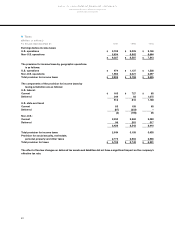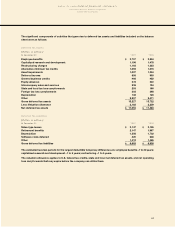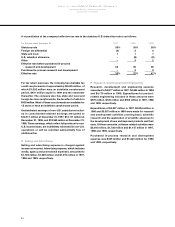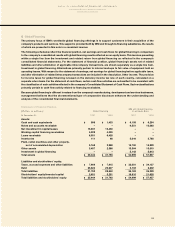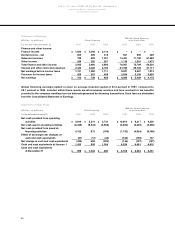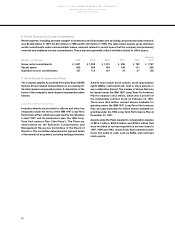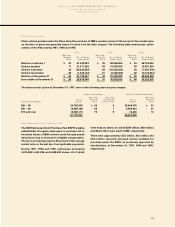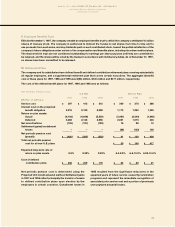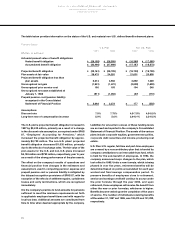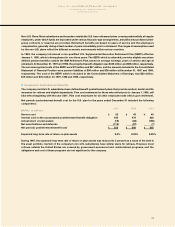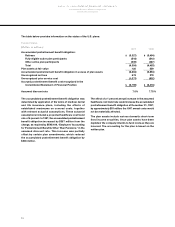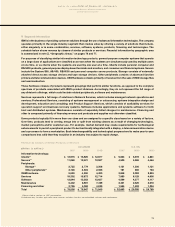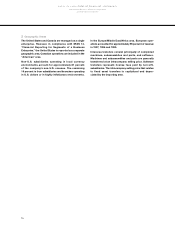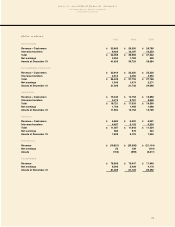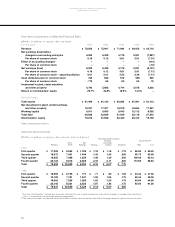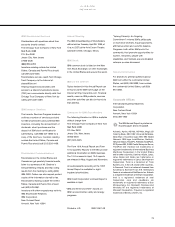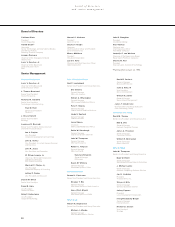IBM 1997 Annual Report Download - page 74
Download and view the complete annual report
Please find page 74 of the 1997 IBM annual report below. You can navigate through the pages in the report by either clicking on the pages listed below, or by using the keyword search tool below to find specific information within the annual report.
72
notes to consolidated financial statements
International Business Machines Corporation
and Subsidiary Companies
The table below provides information on the status of the U.S. and material non-U.S. defined benefit retirement plans:
Funded Status
U.S. Plan Non-U.S. Plans
1997 1996 1997 1996
(Dollars in millions)
Actuarial present value of benefit obligations:
Vested benefit obligation $(29,155) $(26,355) $(16,388) $(17,380)
Accumulated benefit obligation $(30,466) $(27,698) $(17,187) $(18,273)
Projected benefit obligation $(33,161) $(29,729) $(18,709) $(19,739)
Plan assets at fair value 38,475 34,281 21,601 20,808
__________________ __________________ __________________ __________________
Projected benefit obligation less than
plan assets 5,314 4,552 2,892 1,069
Unrecognized net gain (1,901) (1,421) (2,822) (1,539)
Unrecognized prior service cost 190 193 194 248
Unrecognized net asset established at
January 1, 1986 (911) (1,052) (87) (110)
__________________ __________________ __________________ __________________
Prepaid pension cost (pension liability)
recognized in the Consolidated
Statement of Financial Position $2,692 $2,272 $177 $(332)
Assumptions:
Discount rate 7.0% 7.75% 4.5-7.5% 4.5-8.5%
Long-term rate of compensation increase 5.0% 5.0% 2.6-6.1% 2.3-6.5%
The U.S. plan’s projected benefit obligation increased in
1997 by $3,432 million, primarily as a result of a change
in the discount rate assumption, as required under SFAS
87, “Employers’ Accounting for Pensions,” which
increased the projected benefit obligation by approx-
imately $2,723 million. The non-U.S. plans’ projected
benefit obligation decreased $1,030 million, primarily
due to the effects of exchange rates. The fair value of the
plan assets for the U.S. and non-U.S. plans increased
$4,194 million and $793 million, respectively, year to year
as a result of the strong performance of the plan assets.
The effect on the company’s results of operations and
financial position from changes in the estimates and
assumptions used in computing pension expense and
prepaid pension cost or pension liability is mitigated by
the delayed recognition provisions of SFAS 87, with the
exception of the effects of settlement gains, curtailment
losses and early terminations, which are recognized
immediately.
It is the company’s practice to fund amounts for pensions
sufficient to meet the minimum requirements set forth
in applicable employee benefit laws and with regard to
local tax laws. Additional amounts are contributed from
time to time when deemed appropriate by the company.
Liabilities for amounts in excess of these funding levels
are accrued and reported in the company’s Consolidated
Statement of Financial Position. The assets of the various
plans include corporate equities, government securities,
corporate debt securities and income-producing real
estate.
U.S. Plan: U.S. regular, full-time and part-time employees
are covered by a noncontributory plan that is funded by
company contributions to an irrevocable trust fund, which
is held for the sole benefit of employees. In 1994, the
company announced major changes to the plan, which
took effect in 1995. Under a new formula, which is being
phased in over five years, retirement benefits will be
determined based on points accumulated for each year
worked and final average compensation period. To
preserve benefits of employees close to retirement,
service and earnings credit will continue to accrue under
the prior formula through the year 2000, and upon
retirement, these employees will receive the benefit from
either the new or prior formulas, whichever is higher.
Benefits become vested upon the completion of five years
of service. The number of individuals receiving benefits
at December 31, 1997 and 1996, was 108,415 and 101,293,
respectively.


